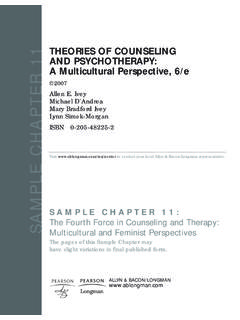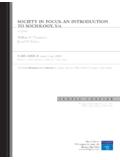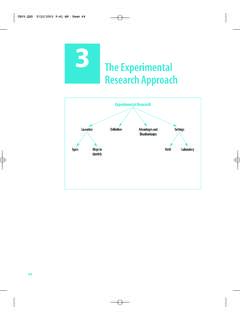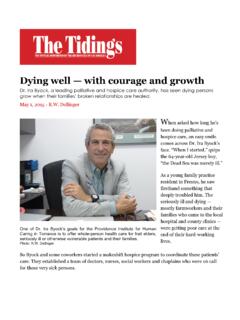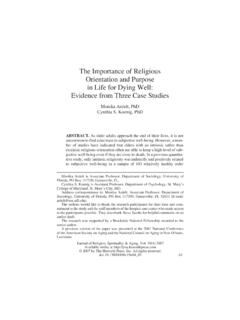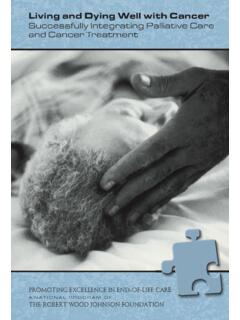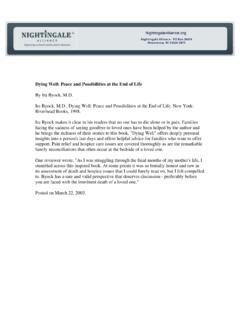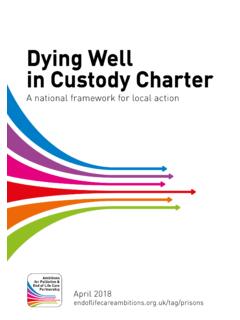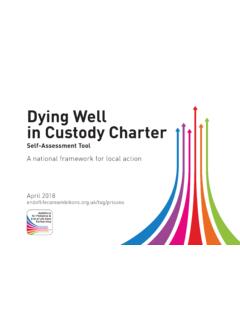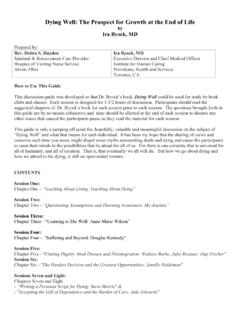Transcription of SOLUTION-FOCUSED THERAPY Insoo Kim Berg Introduction
1 1 SOLUTION-FOCUSED THERAPYWithInsoo Kim BergIntroductionThis video is one in a series portraying effective approaches to THERAPY for addictions. Each videoin the series presents a distinguished practitioner working with a real client. All of the clients involved arepeople who are grappling with the pain of addiction. The therapists demonstrate their methods for makinga difference in a client s life through the vehicle of a brief expert therapists portrayed in this series share some characteristics in common. Each of themis able to develop a respectful, collaborative, and positive relationship with his or her client.
2 Each of themexhibits a sense of optimism about the possibility of change in addictive therapists whose work is highlighted in this series also exhibit some important of the videos focuses on a different approach or model. These models vary in a number of ways,including the following: How does the model explain the addictive process? What assumptions does the model imply about the process of change? How is theory translated to practice in real-life situations? What outcomes are associated with successful THERAPY ? How does the therapist work with people who have mental health problems along with addiction?
3 What kinds of research support the approach? This video begins with a brief interview in which Judy Lewis, Jon Carlson, and the practitioneraddress these questions. We then move on to the actual counseling session. After this demonstration, thetherapist discusses the session with an audience made up of practitioners, educators, and graduate the video series contains actual counseling interviews, professional integrity is required toprotect the confidentiality of the clients who have courageously shared their personal lives with series is designed for use in both educational and practice settings.
4 In educational settings,students embarking on careers in the helping professions can learn about each of the models for addictiontherapy by watching a first-rate therapist demonstrate how it is applied. In practice settings, professionalcounselors, psychologists, social workers, and addiction treatment providers can use these tapes for theirown professional development. Therapists who specialize in addictions and those who work with moregeneral mental health issues will find new and practical ideas for use in their practices. As the trend towardbrief, outpatient THERAPY for addictions accelerates, more and more practitioners can expect to be involvedin addressing addiction-related issues among their to Use the Video1.
5 As a stand alone activity for professional development or orientation to SOLUTION-FOCUSED therapyas it is applied to addictions. If you are using the video this way, you might want to review the listof suggested readings that is included in this study guide. As you watch the video, note thequestions included on the enclosed test. This will help you identify key points related to thismodel. If you wish to apply for continuing education credit, complete the test and submit it As part of an addiction training program. Students or practitioners enrolled in courses orseminars related to addiction can be introduced to addiction THERAPY models by seeing how theyare carried out in practice by renowned therapists.
6 They will value the opportunity to see howmany options are available for effective treatment of As part of a degree program in counseling, psychology, or social work. Students enrolled in pre-professional classes in the helping professions can learn how therapeutic models can be adaptedfor work with addiction-related issues. Although students might not expect to specialize intherapy for addictions, they will need to have appropriate tools in their repertoires for clients whoneed help in this THERAPY for Addictions with Insoo Kim BergSolution-focused THERAPY emphasizes the client s strengths and resources, helping the individualapply the skills and strategies that he or she has used successfully in the past.
7 A SOLUTION-FOCUSED therapistworks under the assumption that the client has the answer to his or her own problem and the skills andresources needed to carry it out. Focus is placed on the client s view of his or her own concerns (not thetherapist s) and on the client s vision for change. Thus, the THERAPY begins with finding out what the clientwants and how he or she will know whether a successful outcome has been reached. This emphasis on thepositive and on the client s interpretation of the need for change makes this approach particularly excitingand innovative for dealing with Kim berg , MSW, is one of the foremost practitioners of the SOLUTION-FOCUSED approach.
8 Sheis co-founder and director of the Brief Family THERAPY Center in Milwaukee, Wisconsin. She works witha very diverse client population, including homeless clients who have had long-term problems withaddiction. She has published extensively and presented popular workshops and seminars all over theworld. With Scott D. Miller, she wrote Working with the Problem Drinker, the first book to exploreapplying the SOLUTION-FOCUSED approach to Objectives1. Identify the central concepts of SOLUTION-FOCUSED Specify how the addictive process is explained by SOLUTION-FOCUSED Describe the specific techniques used to apply SOLUTION-FOCUSED THERAPY in of SOLUTION-FOCUSED THERAPY for Addictions VideoThis video is approximately 105 minutes long and is divided into three parts:Part I: Introduction of the model with Judy Lewis and Jon Carlson interviewing Insoo Kim II.
9 An initial THERAPY session with berg and Carla in which berg helps Carla apply the methods thatshe has used in addressing her previous drug addiction to her current goal of changing her eating III:Discussion of the THERAPY session with Jon Carlson, Judy Lewis, and an audience of practitioners,educators, and THERAPY FOR ADDICTION-RELATED ISSUESBERG - CLIENT BTherapist 1: You have children?Client 1: Yes, I 2: Oh, how many?Client 2: 3: Two children. How old are they?Client 3: 7 and 4: Ooh, lots of 4: Yes, it 5: It takes a lot time. They are not quite big enough to take care of 5: Right, I wish they 6: Right.
10 So going to school and raising two 6: And working part 7: Working part time on top of all this. Wow. I don't know how you do 7: Um, I don't either. Sometimes it's kind of 8: I'm sure it 8: Um, I seem to 9: Wow. You have lots of people helping you out?Client 9: I have a supportive 10: That 10: It does..as well as 11: Well, of 11: Because I attend school full 12: Oh, full time. And you say you work part 12: 13: 13: 14: Wow. And keep up with your school work and all that. That's a lot of 14: It 15: So obviously you are very 15: I try to 16: Yeah?
